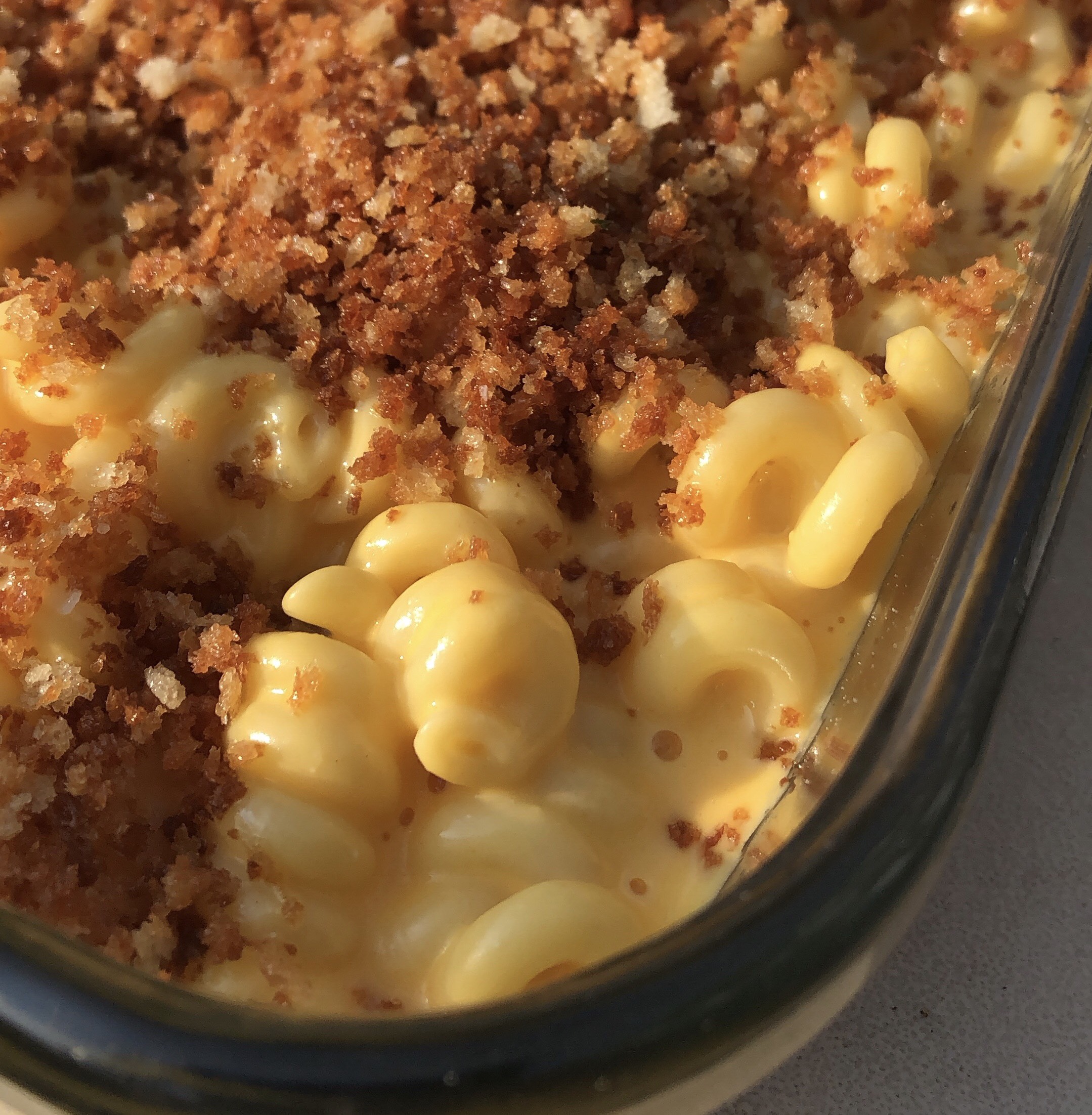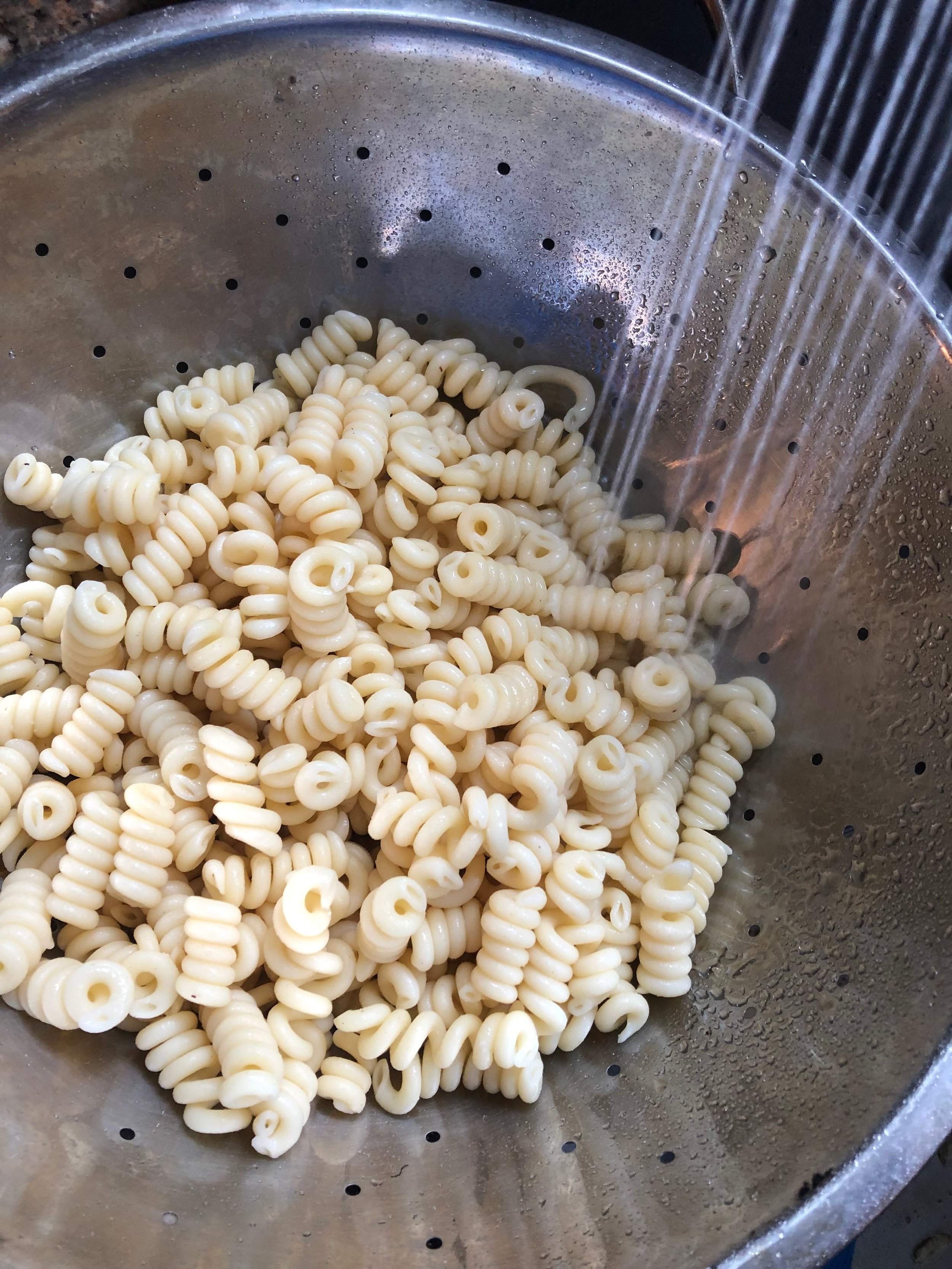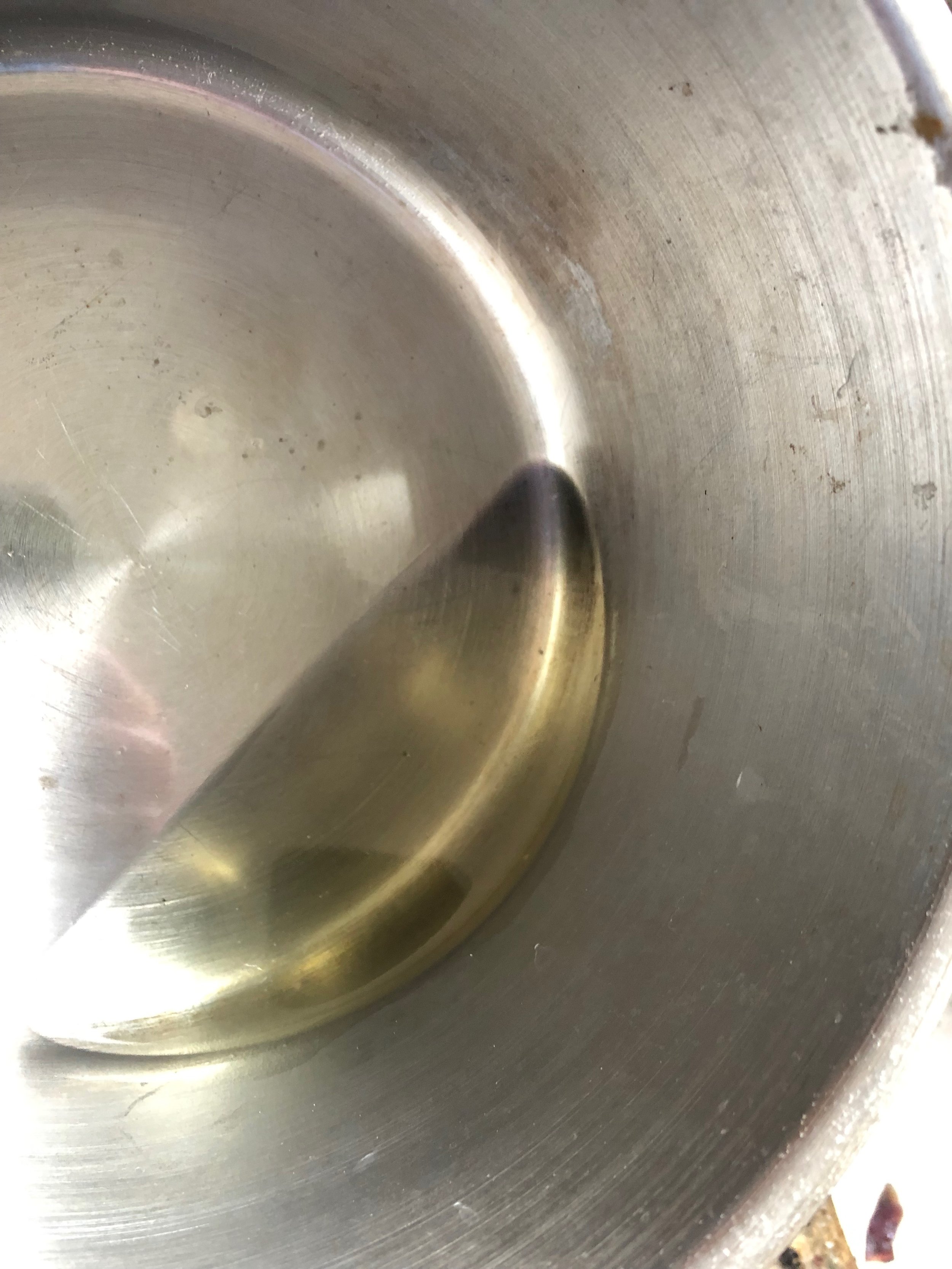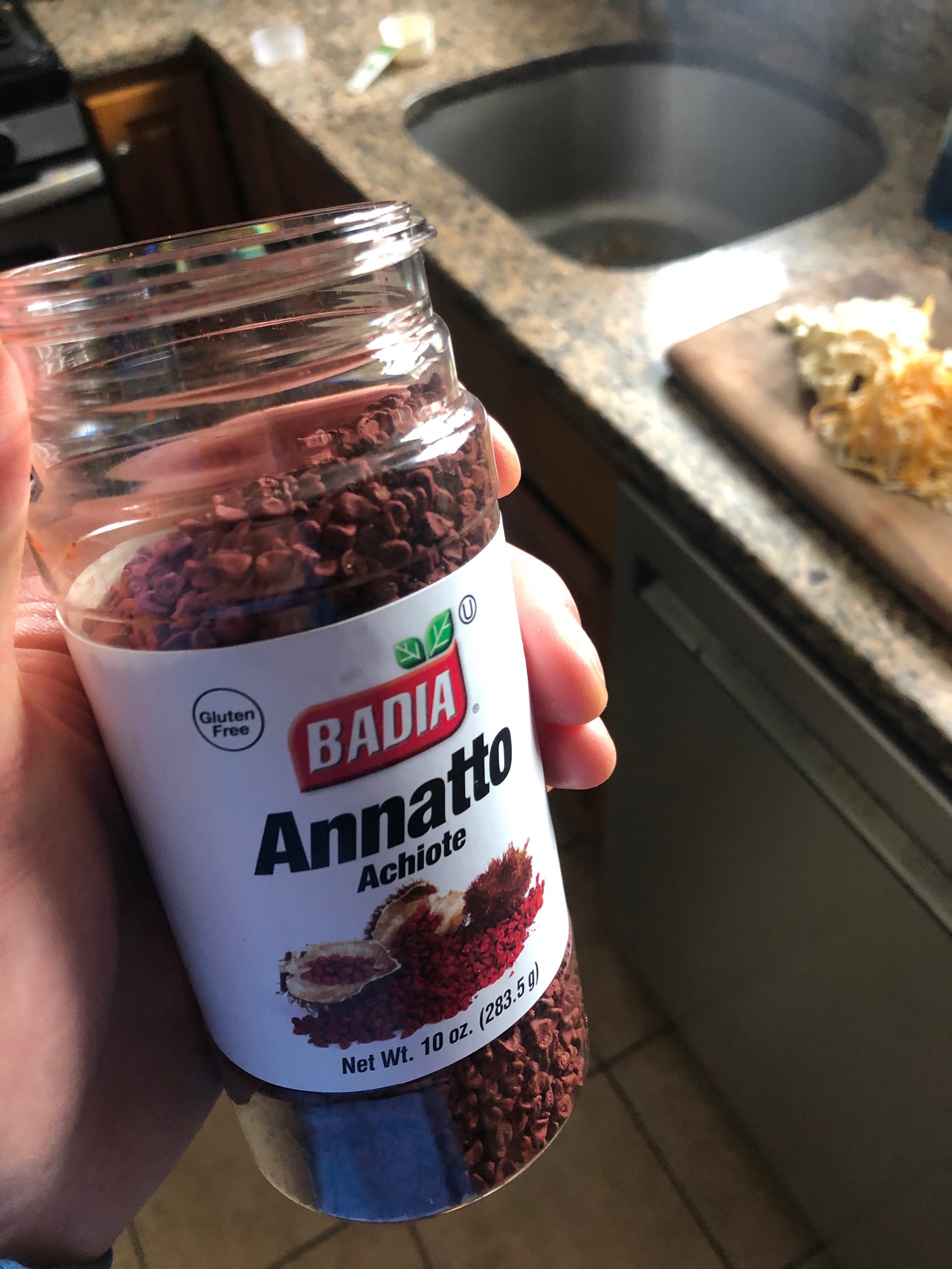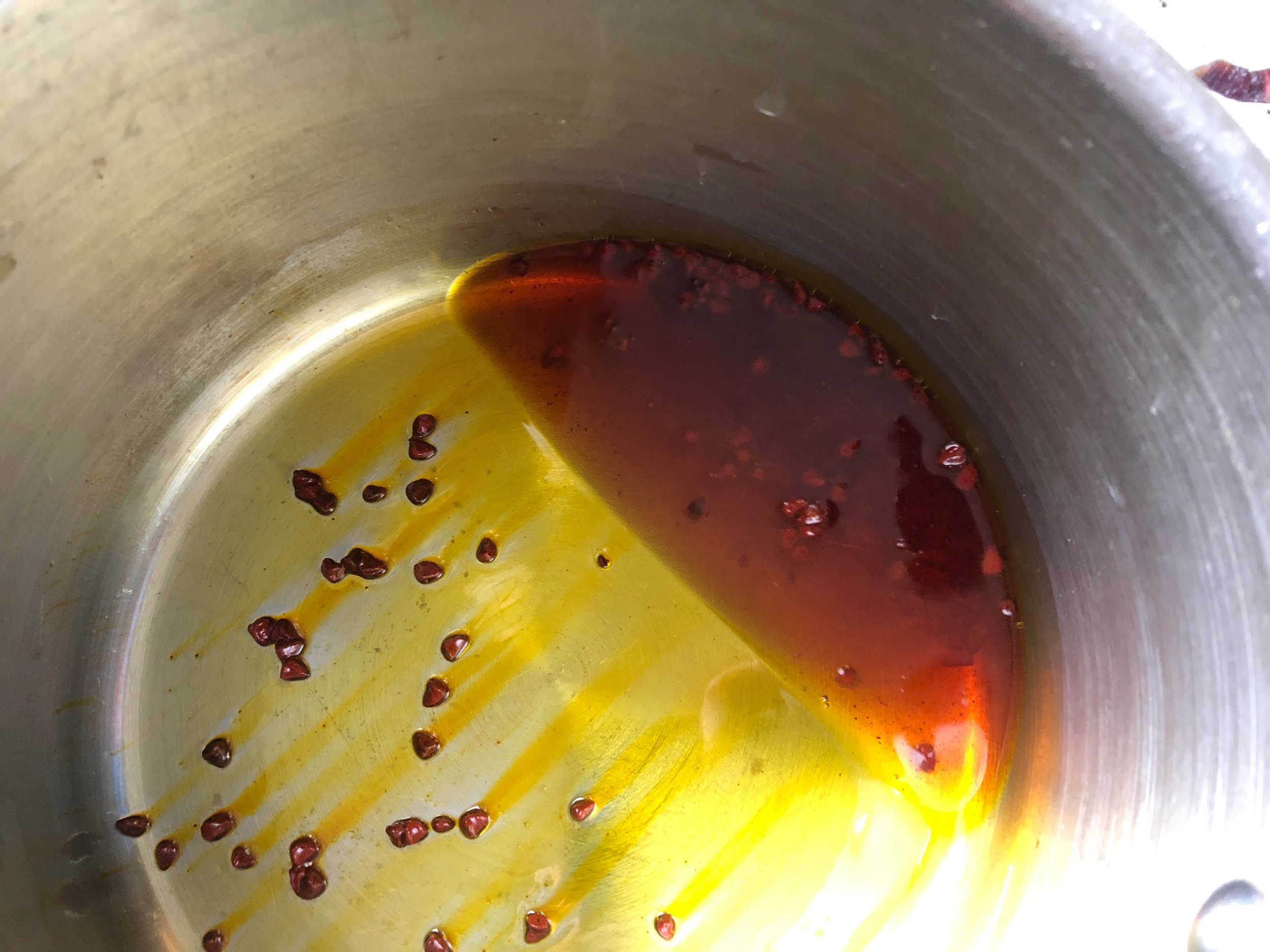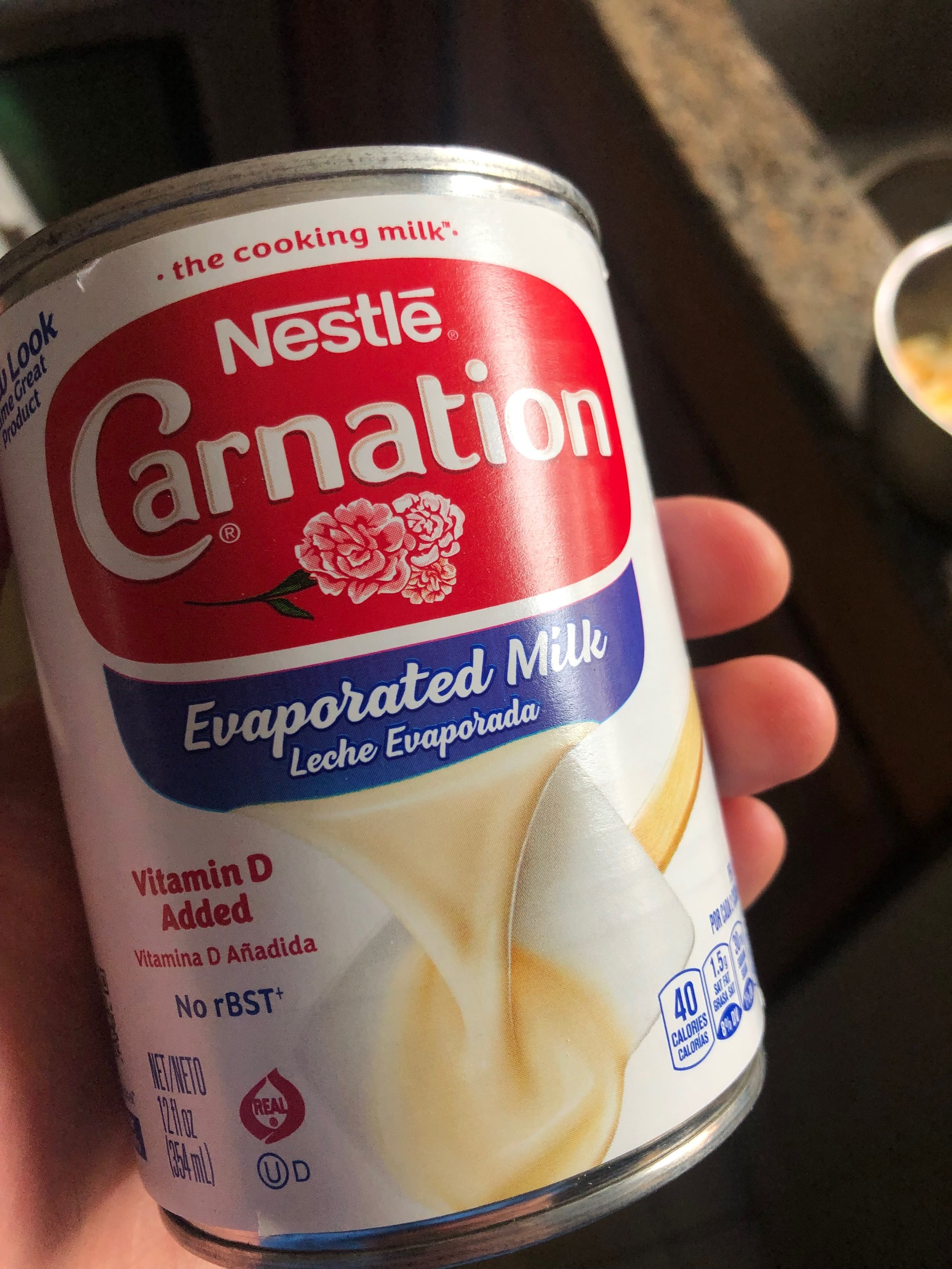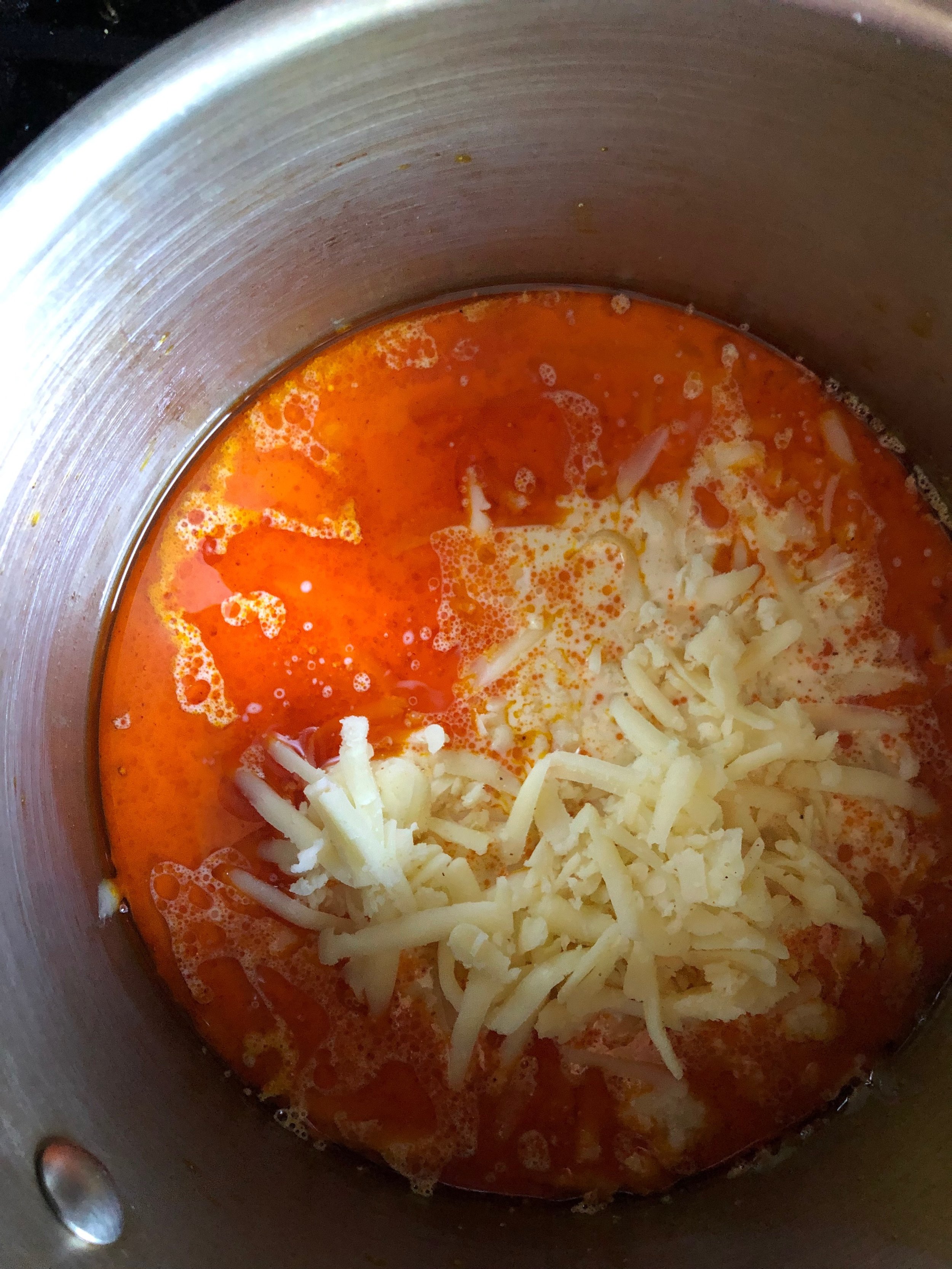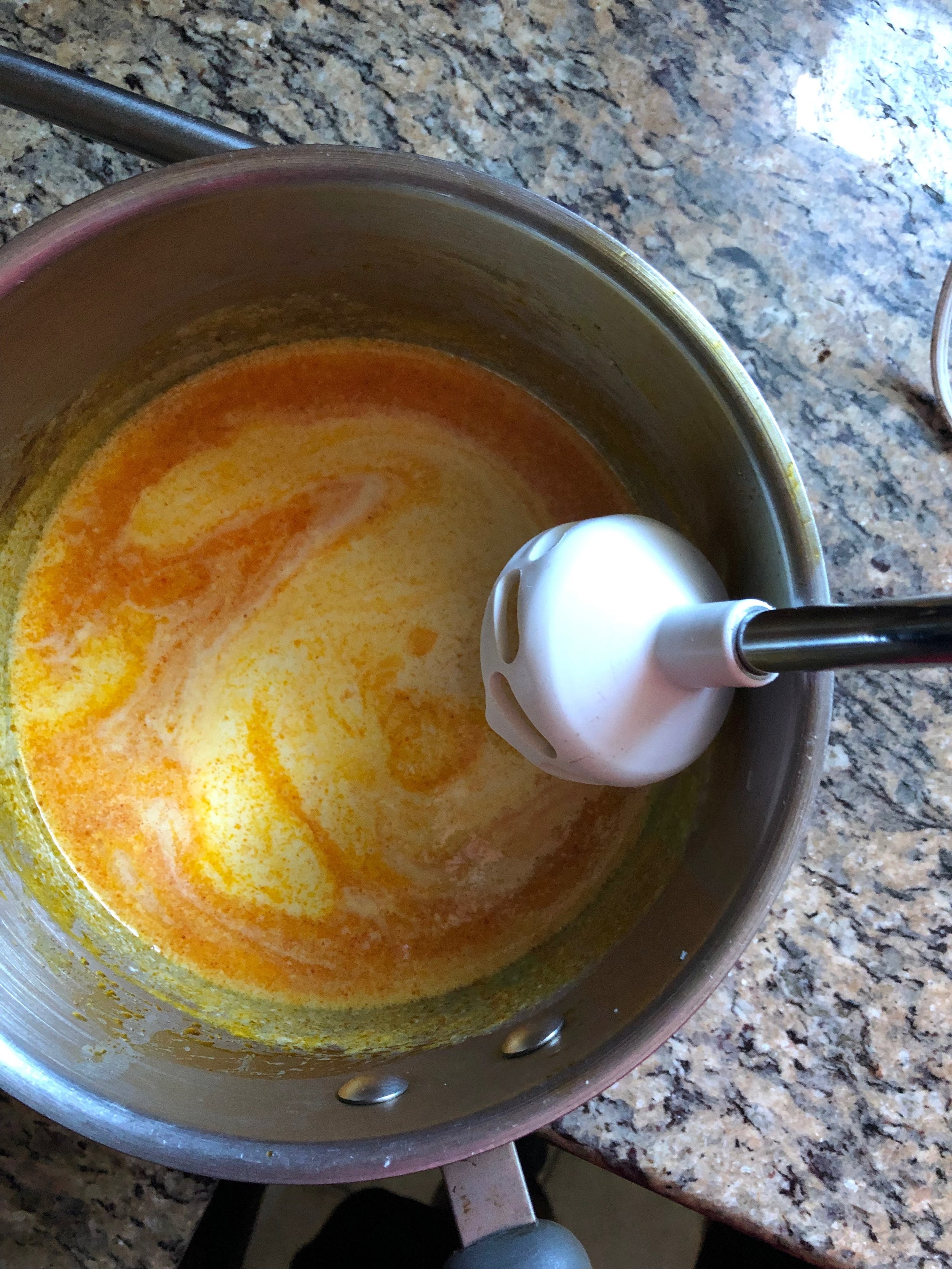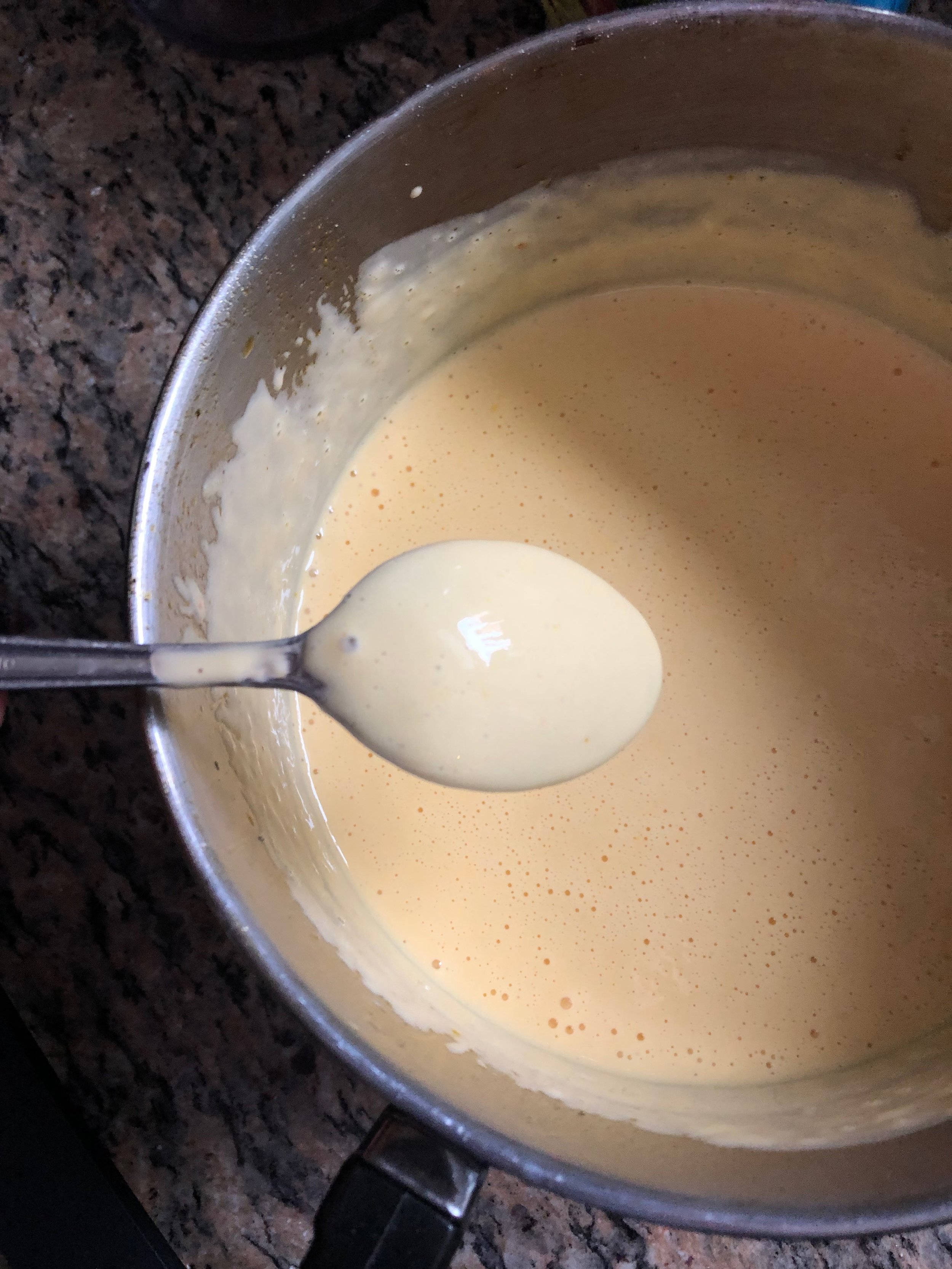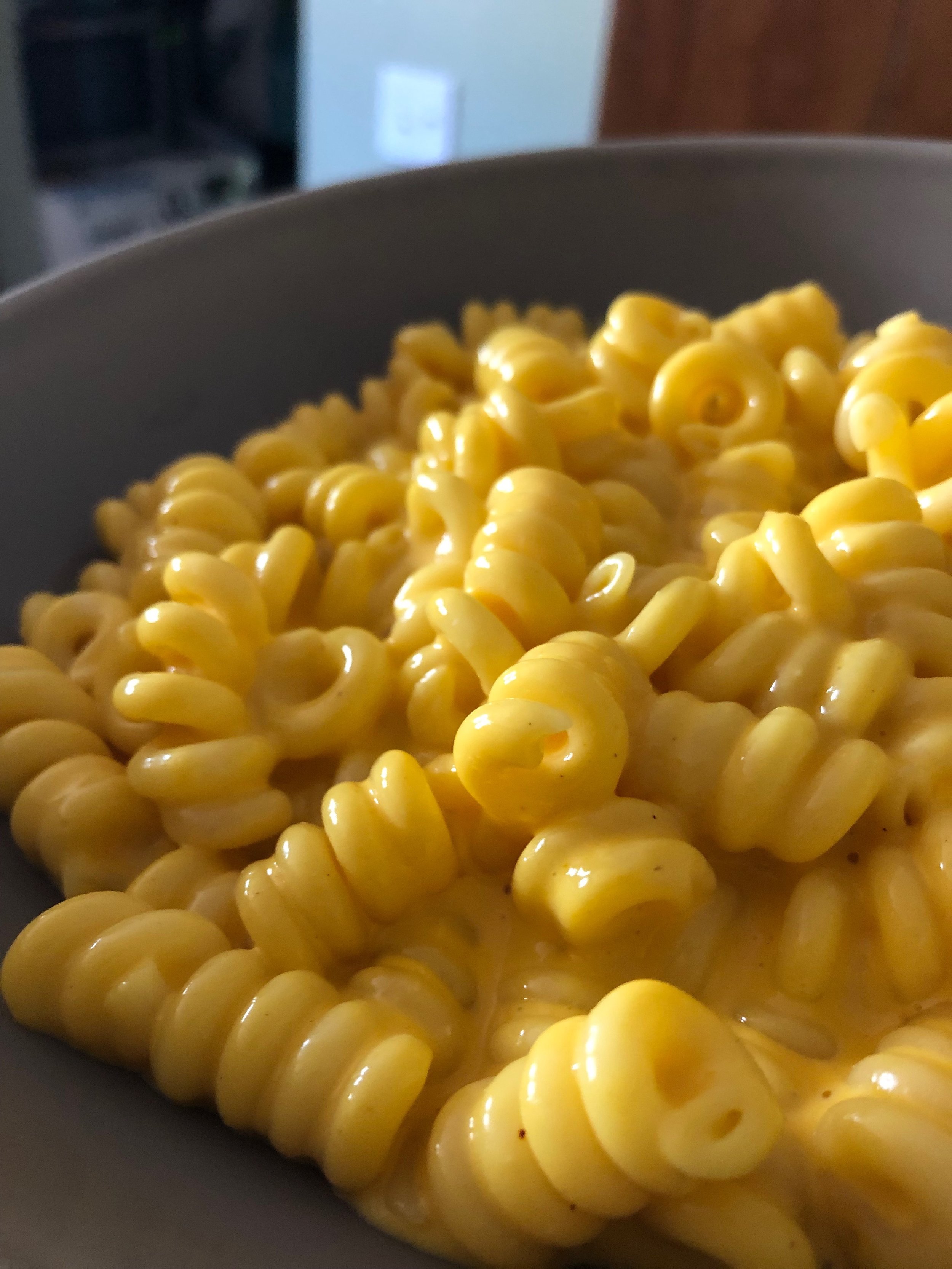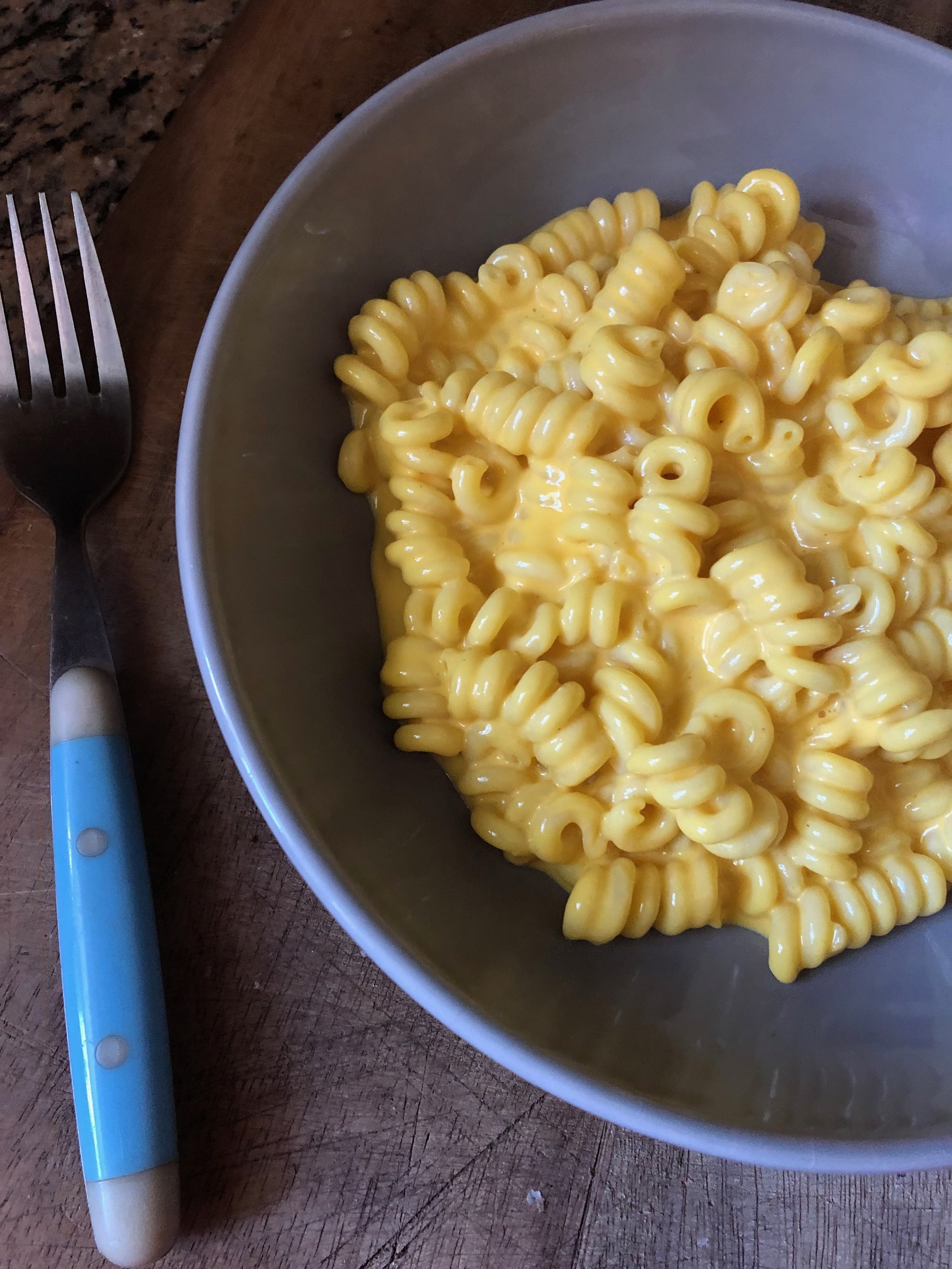All hail the beloved macaroni and cheese. Carbs, fat, and salt… This isn’t healthy, but it just might be the most comforting meal there is.
I admit, I am biased… My favorite mac and cheese growing up always came out of a box. There was nothing better than a bowl of Pokemon (or Spongebob) shaped noodles doused in a salty, suspiciously orange, yet incredibly savory cheese sauce. While I do appreciate the grandma-style baked casserole-trays of ooey gooey mac and cheese, there was always a mysterious allure to those mass-produced boxes of who knows what. My parents never bought the stuff, so maybe my affection was born out of the classic “you want what you don’t have” idea. Regardless, I positively loved this style mac, and I cherished every moment I could have with it. Yes, I was a chubby kid.
For the sake of my childhood, for the Pokemon, for Spongebob, and for all the other kids who ate Kraft (or Annie’s) by the box, I want this mac and cheese recipe to respect everything that made that bowl of nostalgia so alluring. It has to be creamy… maybe a tad bit gooey. It has to be savory, salty, and just familiar enough to poke your nostalgia button. Bonus points will be received for a nice orange hue… and above all, it has to be delicious.
So what do we have to work with? What are the core elements of a dynamite mac and cheese? Let’s break it down
The Noodles
Okay, buy some noodles that you like. Salt the cooking water, and make sure to rinse the starch off when they’re cooked through. This last part is actually pretty important… Too much starch will tighten up your cheese sauce and will make it disappear before your very eyes. I know, starchy water normally helps us with our pasta recipes, but this is an exception. That being said, if you adjusted your ratios, maybe you could use the starchy water in your favor. However, for what we are going for in this recipe, I believe it is best to just remove the starch. The end result is a creamier mac and cheese that remains saucy even after being cooled and reheated.
The. Cheese. Sauce.
This is it. The focal point of this recipe. Thee. Most. Important. Part. It goes without saying that making an excellent cheese sauce is of paramount importance when making an excellent mac and cheese.
This is where things get crazy. Out of all the elements of making mac and cheese, the sauce is by far the most variable. There are so many questions to consider, so many directions you could go, and so many freaking cheeses to choose from. It’s a daunting task, I know, but the most important question we have to ask ourselves is what do we want? Once you have that ~vision~ in your head (or your taste buds), all it takes is knowledge, persistence, a lot of tasting, and a maybe a little luck to successfully transfer that vision into a bowl.
So what is our vision? Well, we sort of outlined it above, but let’s just spew it out again… Sharp, salty, cheesy, rich, creamy, balanced.
Lets start with the “creamy”. The most common way of making a “creamy” mac and cheese is a béchamel sauce. One of the French “mother sauces”, a béchamel is really just milk thickened with a roux made of flour and butter. While you could probably write an article on this alone, we are going to skip right over this topic. Why? Because I don’t want to use a béchamel.
A béchamel might be an easy and convenient way to make a stable, creamy sauce, but all that flour tends to mask the pleasantly sharp flavor of the cheese. It’s this flavor bomb, cheese-forward flavor that defines the essence of a good boxed mac and cheese, so I need to take every precaution I can to protect it. For these reasons, the béchamel has been chopped. Cornstarch is also an option, but I personally think it can add an unpleasant “gloppiness” if you use too much. Also, as a starch, it still can potentially mute the cheese flavor, albeit much less so than flour.
The question now becomes… How do we build a creamy, full-bodied sauce without the addition of starch? Well… melted cheese can certainly add body if melted properly. Eff it, this is mac and cheese… Let’s just melt a whole bunch of cheese and see where it gets us. Our goal is to keep things creamy (and dreamy). To do this, we need to provide the cheese with an environment where it will gladly (and easily) melt away into a stable, homogeneous sauce. How do we do this? Well, let’s look at some pseudoscience spawned from the brain of yours truly.
Like dissolves like – An old mantra I learned in chemistry class.
Can this be applied to the concept of melting cheese with 100% scientific accuracy? Probably not. However, I believe it is a sufficient way to describe my possibly-not-true scientific theories.
Example #1 (like dissolving unlike):
Cheese: Mashup of milk proteins and fat and salt
Water: …It’s water… No protein or fat found here.
Try to melt some cheese into water and you will get an odd, coagulated looking booger thing. No bueno.
Example #2 (like dissolving like)
Cheese: Mashup of milk proteins and fat + some other stuff
Milk: …It’s water… AND milk proteins and fat + some other stuff
Try melting cheese into milk and you should get a better result.
The only problem here is the water in milk… Think about cheese - there is not a whole lot of water in it. Milk, on the other hand, has quite a bit of water in it, making it still relatively “unlike” to most cheeses. You can still force it into a homogeneous sauce by heavy whisking or blending, but the result is an underwhelming, thin, cheesy milk.
In other words we need milk with less water and more of the good stuff. Lucky for us, this product exists… “Evaporated milk” is what its called, and it is exactly what it sounds like… Evaporated milk is just milk that has had a large portion of its water evaporated off, giving it a higher concentration of protein, fat, and other goodies. This makes it the perfect environment for melting cheeses and emulsifying fats, ultimately yielding a creamy, full-bodied sauce.
You can actually achieve a similar result with American cheese. Unlike “real” cheese, American cheese is often just a solidified emulsion of unfermented milk proteins and fat. In other words, it bares a large resemblance to evaporated milk, just in solid form. With this in mind, I actually attempted to use American cheese instead of evaporated milk for one of my batches of mac. It was really easy - just toss a few slices into your pot with some milk. However, the result I got was… for lack of a better word… gross. Perhaps I used too much American cheese, but regardless, the sauce was far too gloppy for my liking. I also didn’t like the processed flavor that the American cheese contributed.
Okay, so we don’t want American cheese… This begs the question… What cheese do we want? I tested several different batches, and while you really could use anything, I found the best results when using really freaking sharp cheddar cheese. See, the evaporated milk + all the fat in the recipe form a relatively mild flavor base. To counter balance all this “mellowness”, we need a really zesty cheese. Seriously, get the sharpest extra-extra-sharp cheddar you can find. Also, even after adding a whole bunch of the world’s sharpest cheddar, you may find that the sauce is still lacking in acidity. If this is the case for your sauce, I encourage you to add a tiny bit of vinegar to help highlight the sharp flavors. I know this sounds weird, but trust me, it works. The cheese packets in boxed mac and cheese often contain powdered “citric acid” or “lactic acid” for the same reason. Heck, if your crazy and have some citric acid laying around, toss it in there instead.
Fat???
Ok, I’ve mentioned fat a lot already, but what fat are we talking about? Well, there is some fat in the cheese and the evaporated milk, but for this recipe, we will mostly be using oil and a smidgen of butter. Look, butter is awesome. Nothing beats it, and it most definitely belongs in your macaroni. However, I find that the mellow-yet-low-key-assertive flavor of butter can easily distract from the sharp cheese flavor that I won’t stop talking about. That being said, there is still a certain fat content that we need to achieve to make this the “optimal” mac, and if we can’t use butter, what can we use?… Any neutral flavored oil. I’m beginning to think I am a super-fan of this ingredient. It may raise some eyebrows, but using oil will allow us to reach an optimal fattiness while still leaving the sharp cheese flavors totally unmasked. I know I mentioned that a little butter is a good thing, and this still holds true… Just a little pad of it will be stirred into the mac at the end.
Other stuff???
The rest of the ingredients are rather minor. Many recipes call for a touch of dried mustard powder, so I put it in this recipe for the heck of it. If you don’t have it, no problem. However, I do think its bitterness accentuate the savory/funky notes of the cheese. A little heat from the cayenne ignites the palate ever so slightly, and the white pepper provides a little balance without adding noticeable color.
Color???
If you want a nice orange hue, you are going to have to get creative. Annatto is a common ingredient in many boxed mac and cheeses due to its ability to add color. If agitated in hot oil, annatto seeds will leech out a deep crimson color that will translate into an orange final product. For this reason, I add a few annatto seeds at the very beginning to develop some color. I know this isn’t the most common ingredient, so this step is totally optional. If you do choose to use it, just make sure to be conservative. The flavor of annatto is easy to hide, but if you use too much, you will start to notice a sort-of rank, fruity, perfumey flavor permeate throughout your mac and cheese. This is not ideal… I’d say a teaspoon is enough to contribute some color, but not enough to significantly alter the flavor. Honestly, you might just be better off using red-food coloring if you’re cool with that… Or forget adding color altogether!
Breadcrumb Topping
Okay, this is one element of the homey, Thanksgiving dinner, casserole-esque mac and cheese that I want to carry over. I’m a big proponent of adding interesting texture to any dish, and this is no exception. If you like the familiar, creamy texture of a plain ‘ol mac and cheese, leave this out! But I just think the little extra crunch steps the experience up a notch. I would recommend it! I just used panko toasted in a lot of butter + some salt. Super simple.
…
Okay… Now that we’ve overthunk the hell out of mac and cheese, it’s time to execute. We’ve suffered, and now it’s time to reap the benefits. I’m hungry, your hungry… let’s make America’s favorite comfort food.
Ingredients
Makes ~4 servings
Pasta
2 tablespoons of neutral oil
8 oz brick of extra sharp cheddar cheese
12 oz can of evaporated milk
1 teaspoon of salt
pinch of cayenne pepper
pinch of white pepper
2 pinches of dried mustard powder
1/2 tablespoon of butter
Optional: 1/2 teaspoon of unassuming vinegar (white or unseasoned rice vinegar are two options).
Method
Bring a pot of salted water to boil over high heat. Add your pasta to the pot.
Add 2 tablespoons of oil to a separate medium sauce pot and set to low heat. Optional: add 1 tsp of annatto seeds and heat until the oil is colored crimson. Removes seeds after a few seconds.
Grate an 8 oz brick of extra-sharp cheddar cheese and add to pot.
Pour a 12 oz can of evaporated milk into the pot.
Add salt and all your spices.
Once the mixture is hot and all the cheese is dissolving, use a hand blender to emulsify it all into a creamy sauce. If you don’t have a hand blender, you can poor it into a counter-top blender or perhaps use a whisk. Optional: if you find that the sauce is missing some “zing”, add a 1/2 tsp of vinegar.
Once the pasta is cooked through, strain with a colander and set under the faucet of your sink. Wash away the excess starch with hot water.
Add a portion of your cooked pasta into the cheese sauce. Mix and add more pasta if needed. Mix in a tab of butter to smooth out the flavors. Season to taste.
For optional breadcrumb topping: 1) melt butter in pan on medium-low heat, 2) add panko and salt, 3) toast until golden brown.
Pour the ooey-gooey goodness into a heated bowl. Dust with breadcrumbs if using. Bask in its glory. Eat with fork or spoon - whatever floats your boat. Enjoy.
Pictures! Note** These were taken from different batches, so the color of the mac and cheese may be inconsistent.


